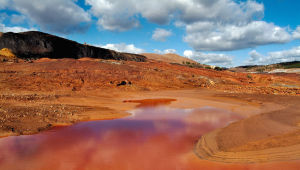*sploosh*
Indonesia
Positioned between the South China Sea, the Pacific Ocean and the Indian Ocean, Indonesia is at the epicentre of marine biodiversity. The area has exhilarating drift diving, extensive reef diving, fantastic night diving, unique muck diving and breathtaking steep walls. The country is also a paradise for underwater photographers as more than 600 coral types and 3000 fish species make their homes on Indonesian reefs.
Philippines
With 7,107 islands (covering a land area of 115,739 square miles/299,746 square km) and a coastline twice the length of the United States, the Philippines can legitimately be called Asia's beach capital. With a tropical climate, warm water, long and white sandy beaches, nearly 15,444 square miles (40,000 square km) of coral reefs, mind-blowingly beautiful flora and fauna, (including many endemic species) - the area is truly a diver's paradise.
Thailand
Known as the “Land of a Thousand Smiles”, Thailand has blossomed as a premier dive destination, with more than 1243 miles (2,000 km) of clear, warm waters, divers can experience sites in both the Andaman Sea off the west coast, and the Gulf of Thailand on the east.
Maldives
In the open oceannear the reefs, you're likely to spot the pelagic animals - including manta rays, eagle rays, tuna and a variety of sharks (including whale sharks). But, for many, the shallows are where they find the best action. The clear, bright water plays host to huge numbers of sweet lips, parrotfish, groupers, snappers as well as the frequent turtles and moray eels. It's an ideal dive environment - especially for underwater photographers.
Separated from any major landmass by thousands of miles of open ocean, Hawaii is one of the remote places in the world and a favourite stopover for large migrating creatures such as humpback whales and whale sharks.
The Red Sea
Sometimes called the Egyptian Riviera, the coastal area runs from the Israeli border at Taba around the Sinai Peninsula through Sharm el–Sheik to the Suez and south along Egypt’s eastern coast to the border with Sudan. Each area tempts divers in its own way, but only the area from El Gouna through Hurghada and Safaga combines the Red Sea’s delights (including spectacular reefs and wrecks), with a proximity to world famous heritage sites such as Luxor and Cairo.
Aruba, Bonaire & Curacao
Aruba, Bonaire and Curaçao, a.k.a. the ABC islands, lie north of Venezuela in the Caribbean in the far-western section of the Leeward Antilles. Year round, the air and water temperature averages 28ºC (82º F) and excellent weather is virtually assured no matter when you visit. Although close together and sharing a broadly common culture, each island offers a completely different vacation experience. If you are looking for diving, beautiful beaches and casinos, choose Aruba. If you live to dive, dive and dive some more, Bonaire is considered one of the world’s top ten destinations. For a unique cultural and cosmopolitan experience mixed with diving, Curaçao provides it. Whatever your choice, the ABCs provide top-notch tropical diving experiences.
Trinidad and Tobago
The 116 square mile (300 square km) Caribbean island of Tobago offers many experiences for the discriminating diver. Just north of Venezuela and south of Grenada, this modest island is home to just over 50,000 people. But, its small size belies its reputation for big diving. With dive sites for every experience level, the healthy reefs feature both hard and soft coral, including the world’s largest brain coral, which measures 12 by 16 feet (four by five metres). But it isn’t just the reefs that thrill - the mobile marine life is also varied and abundant.
Belize
Located between Mexico and Guatemala on Central America’s Caribbean coast, Belize is the perfect destination for adventure, relaxation and exploration. With more than 400 islands, white sandy beaches, the longest unbroken barrier reef in the western hemisphere and 185 miles (298 km) of coastline, Belize is a world-class scuba diving destination. When you’re not diving with nurse sharks or exploring ancient temples and caves, you can embrace this mixture of ancient civilizations, African traditions, British colonial influences and Mestizo lifestyles.
Honduras
The Bay Islands are located approximately 840 miles (1350 km) southwest of Miami and 30 miles (48 kilometres) off the Honduran coast. Consisting of seven islands and 50 small caves, they stretch for 70 miles (113 kilometres) in a northeasterly arc and are part of the Mesoamerican Barrier Reef - the second largest living reef in the world. The prolific waters off of these islands feature vibrant coral, colourful tropical fish, large sponges and the chance for encounters with manta rays, sea turtles and whale sharks.
Italy
Italy offer’s a puzzle of islands – not only the fantastic coasts of Sicily, Siracusa, Taormina, but Lampedusa, Pantelleria and Ustica Islands also boast dark volcanic rocks dressed by huge sea fans. The crystal clear waters provide access to just about any Mediterranean environment, including wrecks dating from Roman times as well as both World Wars.
Cyprus
Likely named for its most famous daughter, Aphrodite (the goddess of love and beauty), Cyprus is nestled in the Northeast corner of the Eastern Mediterranean Sea. Providing simple, sandy-bottom dives for beginners, the island's diving offers something for everyone. Water temperatures range from 16° - 27° C (60°-80° F), which provides one of the longest dive seasons in the Mediterranean. Plus, the area boasts great visibility – 65 - 115+ feet (20 - 35+ metres) nearly all year.
The clear, bright water plays host to huge numbers of sweet lips, parrotfish, groupers, snappers as well as the frequent turtles and moray eels. It's an ideal dive environment
Riviera Maya
Located on Mexico’s Yucatan Peninsula in the state of Quintana Roo, the Riviera Mayaand Cancun provide easy access to the Great Mesoamerican Reef. Stretching 450 miles (724 km) from the tip of Cancun south to the Bay Islands in Honduras, the world's second largest reef is home to more than 150 species of reef fish and nearly 100 coral species. In addition, freshwater sinkholes called cenotes are prevalent throughout the Yucatan Peninsula.
Cozumel
Located 10 miles (16 km) off Mexico's Yucatán Peninsula, the island of Cozumel is one of the most popular scuba diving destinations in the Caribbean. Cozumel has all the ingredients for a great getaway: friendly locals, good food, lively nightspots, towering coral formations, warm water, great underwater visibility and white sandy beaches. Plus, the peaceful currents mean serene drift dives at most sites.
Hawaii
Separated from any major landmass by thousands of miles of open ocean, Hawaii is one of the remote places in the world and a favourite stopover for large migrating creatures such as humpback whales and whale sharks. Not only that, one-third of the marine life you'll encounter diving in the Hawaiian Islands isn't found anywhere else.
Florida
Florida’s diverse dive offerings run the gamut from fresh water to salt water and cave diving to drift diving. The state of Florida offers more shipwrecks than many countries! Florida pretty much has it all and the best part? You can dive it.
Turks and Caicos
The alluring turquoise waters of the Turks and Caicos Islandsfeature a vast, thriving coral reef ecosystem. Whether you’re looking for breathtaking walls or dive wrecks, tropical diving in the Turks and Caicos is both accessible and impressive.
For more from GF Explorer head to the website at www.glenfiddichexplorers.com, or to create and share your own lists visitwww.glenfiddich.com/explorers
Click here for more Travel stories
Click here to follow Sabotage Times on Twitter
Click here to follow Sabotage Times on Facebook



